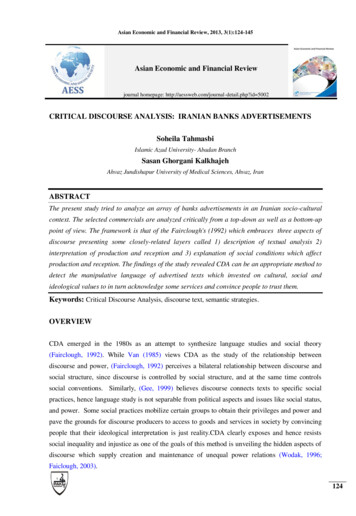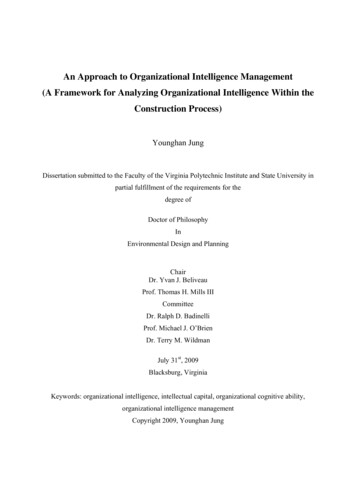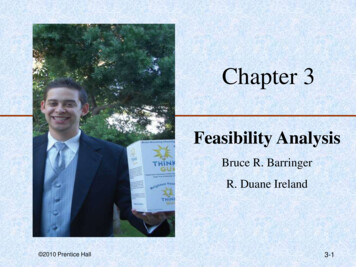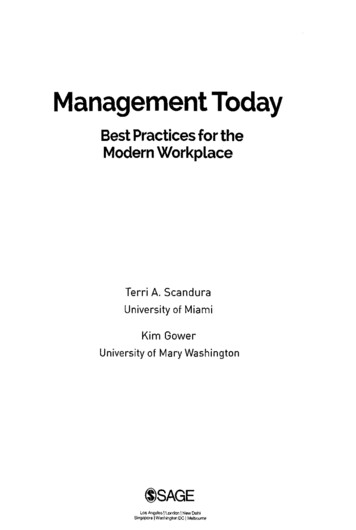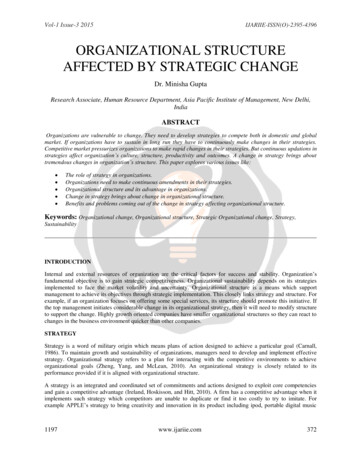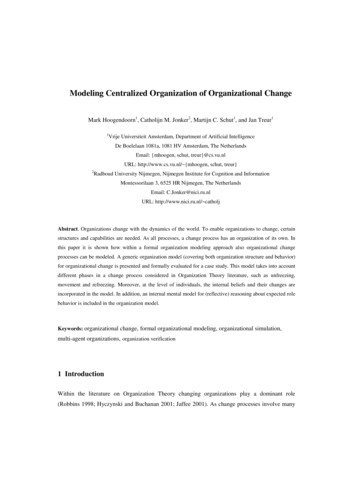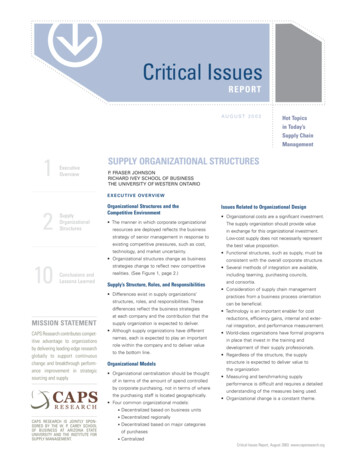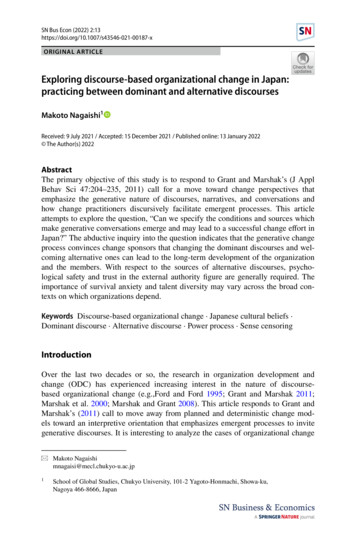
Transcription
SN Bus Econ (2022) INAL ARTICLEExploring discourse‑based organizational change in Japan:practicing between dominant and alternative discoursesMakoto Nagaishi1Received: 9 July 2021 / Accepted: 15 December 2021 / Published online: 13 January 2022 The Author(s) 2022AbstractThe primary objective of this study is to respond to Grant and Marshak’s (J ApplBehav Sci 47:204–235, 2011) call for a move toward change perspectives thatemphasize the generative nature of discourses, narratives, and conversations andhow change practitioners discursively facilitate emergent processes. This articleattempts to explore the question, “Can we specify the conditions and sources whichmake generative conversations emerge and may lead to a successful change effort inJapan?” The abductive inquiry into the question indicates that the generative changeprocess convinces change sponsors that changing the dominant discourses and welcoming alternative ones can lead to the long-term development of the organizationand the members. With respect to the sources of alternative discourses, psychological safety and trust in the external authority figure are generally required. Theimportance of survival anxiety and talent diversity may vary across the broad contexts on which organizations depend.Keywords Discourse-based organizational change · Japanese cultural beliefs ·Dominant discourse · Alternative discourse · Power process · Sense censoringIntroductionOver the last two decades or so, the research in organization development andchange (ODC) has experienced increasing interest in the nature of discoursebased organizational change (e.g.,Ford and Ford 1995; Grant and Marshak 2011;Marshak et al. 2000; Marshak and Grant 2008). This article responds to Grant andMarshak’s (2011) call to move away from planned and deterministic change models toward an interpretive orientation that emphasizes emergent processes to invitegenerative discourses. It is interesting to analyze the cases of organizational change* Makoto Nagaishimnagaisi@mecl.chukyo-u.ac.jp1School of Global Studies, Chukyo University, 101‑2 Yagoto‑Honmachi, Showa‑ku,Nagoya 466‑8666, JapanVol.:(0123456789)
13 Page 2 of 24SN Bus Econ (2022) 2:13in Japan, where people have a cultural inclination to respect strong hierarchies andauthority figures that shape dominant discourses in organizations. With an abductive approach, the present study explores whether we can specify the conditions andsources that result in generative conversations and may lead to a successful changeeffort in Japan. Namely, this study intends to fill the research gap to make the literature more grounded on data in a certain cultural setting.The article is structured as follows. The following section deals with the reviewof literature in the studies of Japanese organizational culture and discourse-basedorganizational change. It is closely related to the application of the linguistic turn insocial sciences, for which there is a growing body of literature in organization studies. The third section focuses on four dominant cultural beliefs in Japanese organizations. It attempts to analyze the possibility of the coexistence of good and bad fitsbetween the beliefs and key discourse-based organizing assumptions. In the fourthsection, the methodology is outlined, and some fundamental research questions areframed. The fifth section provides a detailed analysis of organizational discourse andchange, focusing on the author’s field studies in Japanese companies. The sixth section introduces some implications of these case studies. It suggests that the generative nature of the change process emerges when change sponsors buy in the proposition that changing the dominant discourses and welcoming alternative ones can leadto the long-term development of the organizations and themselves. The final sectionprovides some concluding remarks and scope for future research.Japanese cultural beliefs and discourse‑based change assumptionsJapanese cultural beliefsEshun Hamaguchi (1982), who contrasts Japanese socio-cultural characteristicswith Western ones, has further developed Hsu’s (1963, 1971) line of research forunderstanding the concept of human relationships in Japan. He names the Japanesesocio-cultural model “Contextualism.” Its characteristics are (a) mutual dependence(human being cannot, in essence, live independently in a society), (b) mutual trust(interdependency can be natural only if a relationship is trustworthy), and (c) interpersonal relations as an end (sustaining a good relationship is not a means for anindividual’s survival but an end in itself for social life). At this point, it may be helpful to explain some crucial aspects of the Japanese societal culture in connectionwith the formalized Japanese Contextualism mentioned above.High‑context communicationAs a critical cultural differentiator, high-context and low-context communicationstyles (Hall 1976) are widely accepted and empirically examined in the research oncross-cultural management (Aslani et al. 2016; Hofstede 2001; Hofstede and Bond1988; Jaeger 1986). According to Meyer (2014, p 39), a high-context communication society believes that “good communication is sophisticated, nuanced, and layered. Messages are both spoken and read between the lines. Messages are often
SN Bus Econ (2022) 2:13Page 3 of 24 13implied but not plainly expressed.” Recent cross-cultural studies also point out thatJapan has the distinction of being the highest-context culture in the world (Adairet al. 2015; Barkema et al. 2015; Meyer 2014; Szkudlarek et al. 2020).LaCour’s (2016) essential learning from his visit to Japan was his understanding of a Japanese aphorism “ichi ieba ju wakaru,” which means “(f)rom the speaker’s articulated 10%, the listener should deduce the other 90%,” and this “illustratesan acculturated non-verbal communication pattern actualized in a shared contextbetween speaker–listener” (LaCour 2016, p 66). Some Japanese communicationpatterns (e.g., “Read carefully between the lines of my writings” and “Understandmy intention without asking me”) frequently delivered by bosses to subordinates arenotable examples of their preference for high-context communication styles.One explanation for the Japanese orientation to high-context communication isthe insularity and reliance on highly interdependent rice cultivation, which has builtstrict in-group cultural norms. According to these norms, both rewards and punishments are based on the level of assimilation in dominant narratives and contexts.This assimilation pressure is called “harmony orientation,” which means avoidingconfrontation and disruption is appropriate to sustain a good relationship at theworkplace. From the viewpoint of leadership, the harmony orientation of both Japanese leaders and followers often induces a strong disinclination to deviate from thestatus quo in their organizational life (Nagaishi 2014).Company as family‑tie pressureIntense pressures to be loyal and attached to groups/organizations are the characteristics of Japanese society (Keys and Miller 1984; Ouchi 1981). Some researchersargue that Japanese business leaders have utilized the Japanese cultural heritage ofstrong family-tie pressures to force collective discipline to promote company performance (Doi 1989; Keys and Miller 1984; Tanaka 1981; Trompenaars and Woolliams2003). As Keys and Miller (1984, pp 347–348) point out, “(b)ecause the companybecomes a surrogate for the family, work takes on the same ethos as a contribution to the family-loyalty, sincerity, and so on. The company’s (family’s) prosperitybecomes more important than individual prosperity, and work for the company (notleisure) becomes the essence of life.” Besides, it is traditionally believed that a fatheris an authority figure in the Japanese family who decides what is right.This orientation has various organizational implications in Japan. Firstly, theJapanese managers eagerly inspire their followers to go beyond their self-intereststo benefit the larger group. Secondly, Japanese managers tend to regard their teammembers as their children and raise and motivate them from a long-term perspective. In return, members are expected to practice filial piety and be loyal to theirmanagers. This cultural norm, combined with the impacts of the Confucian philosophy (Marshak 1993a) and the Buddhist religious foundation (Teranishi 2018), leadsto the long-term perspective among the Japanese to respect gradual and continuous development of processes and human beings. Thirdly, the idolization of “fatheras-an-authority figure” has been recast into Japanese high power-distance culture
13 Page 4 of 24SN Bus Econ (2022) 2:13(Hofstede 2001), and the authoritarian pressure leads members to hide or restricttheir judgments.1Discourse‑based organizational changeSome researchers who are interested in delineating the dynamics of generativechange in organizations rely heavily upon a discourse-based approach derivedfrom literature on organizational communication (Clark and Geppert 2011; Grantand Marshak 2011; Heracleous and Barrett 2001; Whittle et al. 2016). In this section, some working definitions of the key concepts have been provided to conveyhow they should be understood in the context of the discourse-based organizationalchange approach on which the author’s analytical framework relies. The definitionsare drawn from relevant social science literature, specifically in the fields of ODCand Japanese organizational culture.Grant and Marshak’s (2011) seven dimensions of discourse‑based organizationalchangeGrant and Marshak’s (2011) study is a seminal contribution to the subject of discourse-based organizational change. They have advanced an analytic frameworkexplaining how discourse and organizational change are mutually implicated froman interpretivist orientation. Based on the core premise that organizational change iscreated and sustained through discourse, they summarize the following seven basicassumptions about organizing and leading the discursive change processes. (DOC1) Discourse is constructive; changing the dominant discourse leads tochange.(DOC2) There are multiple levels of linked discourses influencing change.(DOC3) Change narratives are constructed and disseminated via conversations.(DOC4) Power processes shape the dominant discourse about change.(DOC5) Alternative discourses exist and may be drawn upon.(DOC6) Reflexivity increases the efficacy of the discourses used by changeagents and researchers. (DOC7) Change discourses emerge from a continuous, iterative, and recursiveprocess. These interrelated dimensions suggest “how things are framed and talked aboutbecomes a significant context that shapes how change agents, affected employees, and other stakeholders think about and respond to a change related issue or1Hofstede (1980, 2001) advances a pioneering dimensional framework for characterizing cultures. Hisframework and findings dominate current international management studies. He addresses five culturaldimensions: (a) power distance, which concerns social inequality and relations with authority; (b) uncertainty avoidance, which concerns cultural preferences for dealing with uncertainty; (c) individualism–collectivism, which refers to the strength of the ties that people have with others within their community;(d) masculinity–femininity, which concerns the social implications of gender-linked behavior; (e) longterm/short-term orientation, which shows the relative importance of the future.
SN Bus Econ (2022) 2:13Page 5 of 24 13situation, or even the possibility of change itself” (Grant and Marshak 2011, p 207).The framework reveals some crucial practical insights into how discursive processes (e.g., storytelling and conversations) might increase the likelihood of effective organizational change. This practical viewpoint is decisively different from theexisting discourse-based change studies (Barrett et al. 1995; Heracleous and Barrett2001).Social constructionismThis article examines a meta-theory on which discourse-based organizational changerelies by considering the nature of social constructionism, which has a significant impact on the narratives of the field (Bushe and Marshak 2015; Barrett 2015;Cooperrider et al. 1995). Based on Berger and Luckmann’s (1966) fundamental ideathat social reality is created by human interaction, Gergen (1985, pp 266–268) summarizes the following four critical premises of social constructionism: (a) what wetake to be an experience of the world does not in itself dictate the terms by which theworld is understood, (b) the terms in which the world is understood are social artifacts of historically situated interactions among the people, (c) the degree to whicha given form of understanding prevails or is sustained across time is fundamentallydependent on the vicissitudes of social processes and not on the empirical validity ofthe perspective in question, and (d) forms of negotiated understanding are critical insocial life because they are integral to many other activities in which people engage.Given the Japanese characteristics summarized in the previous sub-section, it canbe assumed that social constructionism has a good fit with some aspects of Japaneseorganizational culture. Specifically, (b) and (d) are reasonably similar to those of theJapanese culture of high-context communication (meanings are social constructs ofthe interactions and depend on the context/history). Another possibility, however,is to say that its no-reality/no-solution approach may have potential conflicts withthe Japanese “family-tie orientation” culture, which leads members to regard theirauthority figure’s judgments as concrete solutions (Keys and Miller 1984; Tanaka1981).Sense‑censoring and strategic ination (political sensemaking approach)It may also be worth extending the discourse-based perspective to an interpretivistapproach to the political process of organizational communication. In this respect, itis critical to consider two recent studies in international management studies.Clark and Geppert (2011) have focused on a political sensemaking approach2to the post-acquisition integration process, directing attention to how powerfullysocial actors construct the relationship between multinational corporations and their2Sensemaking is one of the core concepts in the interpretivist approach and is defined as the recurringcycle of communication through which people create and maintain an intersubjective world. It is also“understood as a process that is (a) grounded in identity construction, (b) retrospective, (c) enactive ofsensible environments, (d) social, (e) ongoing, (f) focused on and by extracted cues, (g) driven by plausibility rather than accuracy” (Weick 1995, p 17).
13 Page 6 of 24SN Bus Econ (2022) 2:13Table 1 Japanese cultural beliefs in organizations1. Avoiding confrontation and disruption is appropriate behavior to sustain a good relationship at theworkplace2. Saving face by avoiding shame and being demeaning in public talk is highly prioritized3. An authority figure always decides what is right; the authoritarian pressure leads members to hide orrestrict their judgments4. Gradual and continuous development of organizations and human resources is traditionally valuablemultiple local contexts. Their model identifies a broad set of conditions under whichthe new way of thinking about subsidiary integration is developed by focusing onthe processes of identity reconstruction and institution building.Whittle et al. (2016) developed Clark and Geppert’s (2011) political sensemakingapproach and studied a mechanism of political processes between the headquartersof an American multinational corporation and their subsidiary in Britain. Addingto the existing body of sensemaking-related constructs (Maitlis and Christianson2014), they define sense-censoring as “the process through which actors consciously‘censor’ their sensemaking accounts, with or without the presence of any officialattempts to edit or silence them, due to anticipated reactions or counter-actions”(Whittle et al. 2016, p 1324). Sensemaking about power and politics, thereby, leadsto sense-censoring (saying nothing) and may cause strategic inaction (doing nothing) that allows the crisis to mushroom and ultimately ends up costing the firm hundreds of millions of dollars and significant reputational damage.The fit between Japanese organizational culture and discourse‑based changeFrom the literature introduced in the previous section, combined with a more practical interpretation of leadership in Japan (Nagaishi 2020), this article attempts toextract the following four aspects of Japanese organizational culture (Table 1): (JOC1) Avoiding confrontation and disruption is an appropriate behavior to sus-tain a good relationship at the workplace (Hamaguchi 1982; Nagaishi 2020). (JOC2) Saving face by avoiding shame and being demeaning in public talk ishighly prioritized (Aslani et al. 2016; Keys and Miller 1984; Tanaka 1981). (JOC3) An authority figure always decides what is right; the authoritarian pres-sure leads members to hide or restrict their judgments (Keys and Miller 1984;Nagaishi 2020; Tanaka 1981). (JOC4) The Japanese orientation toward intimacy and family ties leads to a collectivistic long-term perspective of respecting the gradual and continuous development of organizations and human resources (Marshak 1993a; Nagaishi 2020;Teranishi 2018).
Page 7 of 24 13SN Bus Econ (2022) 2:13Discourse-based change assumptionsJapanese cultural beliefsDiscourse is construc ve; changing thedominant discourse leads to changeThere are mul ple levels of linkeddiscourses influencing changeAvoiding confronta on and disrup on isappropriate behavior to sustain a goodrela onship at the workplaceChange narra ves are constructed anddisseminated via conversa onsSaving face by avoiding shame and beingdemeaning in public talk is highlypriori zedPower processes shape the dominantdiscourse about changeAn authority figure always decides what isright; the authoritarian pressure leadsmembers to hide or restrict theirjudgmentsAlterna ve discourses exist and may bedrawn uponGradual and con nuous development oforganiza ons and human resources istradi onally valuableReflexivity increases the efficacy of thediscourses used by change agents andresearchersChange discourses emerge from acon nuous, itera ve and recursiveprocessGood fitBad fitFig. 1 Discourse-based change assumptions and Japanese cultureThese four cultural aspects are reasonably compatible with Hofstede’s (1980,2001) cultural evaluation of Japan, which includes high power distance (that cancause JOC3), high uncertainty avoidance (JOC1 and JOC2), high collectivism(JOC1 and JOC4), and high long-term orientation (JOC4).Figure 1 summarizes the overall fit between the discourse-based change assumptions (DOC1–7) and Japanese organizational culture (JOC1–4). As depicted in thefigure, it seems reasonable for the author to conclude that the results are mixed;there are some good fits and some bad fits.For example, on the one hand, the figure clearly illustrates that Japanese collectivistic long-term perspective to respect gradual and continuous developmentof organizations and human resources (JOC4) has a good fit with discourse-basedchange assumptions of the recursive change process based on reflexivity (DOC6–7).In the literature on the organizational structure of MNEs, there is fairly a generalagreement on the point that Japanese firms share certain collectivistic long-termperspectives, as opposed to the individualistic and short-term ones of Anglo-Saxonfirms; one of the differences in the literature is whether they deal with the historical
13 Page 8 of 24SN Bus Econ (2022) 2:13and cultural factors explicitly (Itagaki 1997; Nagaishi 2014) or not (Kojima 1978;Caves 1982). Such a collectivistic long-term perspective of Japanese organizations,combined with the impacts of the Confucian philosophy (Marshak 1993a) and theBuddhist religious foundation (Teranishi 2018), seems a good match for the viewpoint of the discourse-based change mindset that advocates continuous and adaptivenature of reframing organizational communication with multiple discursive changesoccurring at various levels and speeds.On the other hand, it also highlights that the Japanese may not easily buy in theimportance of changing the dominant discourse with welcoming multiple/alternative discourses (DOC1, 2, 5) due to their hidden assumptions like “the boss has anauthority to decide what is right” (JOC3). This finding implies that the discoursebased interpretivist perspective does not match Japanese authoritarian orientation inwhich “an authority figure as a definite decision-maker” is a sticky premise, and thepressure leads members to hide or restrict their judgments.Although much work remains to be done, the preliminary results from the aboveanalysis indicate an overall mixed fit between the discourse-based change assumptions and Japanese organizational culture. In particular, while the Japanese culturalbrief to respect gradual and continuous process development has good potential tofit the reflexive and recursive nature of discourse-based change, the discursive belief(i.e., making change happen by changing the dominant discourse) has a bad fit withthe Japanese orientation to strong hierarchies and authoritarian leadership. Besides,given the Japanese inclination to saving face by avoiding shame and being demeaning in public talk (this tendency may be a rational response to Japanese authoritarianculture), it is plausible to assume that surfacing alternative discourses in organizations is always a risky option for all members.Here are two critical questions for change agents practicing within Japaneseorganizational culture. First, who are the most influential actors in shaping dominantdiscourse, and what are the sources of their influence? Second, given the Japaneseauthoritarian orientation, how can change practitioners identify and use alternative discourses at multiple levels to support change processes? These questions forchange practice are intertwined with the research questions introduced in the nextsection.Methodology and research questionsThe author was invited into the company to act as an ‘action researcher’ to providehis (unremunerated) assistance in two Japanese companies’ strategic change initiatives, in return for being permitted to collect data for academic purposes. He tried toilluminate how discursive methods could advance organizational change research ina particular cultural setting, i.e., Japanese companies. In particular, the studies highlighted the stories on who was the most influential in shaping discourses and whatwere the sources and consequences of their influence.The author focuses on two things in the case studies: (a) power process and (b)possibility for alternative discourse. The first originates from the question in the previous section, i.e., who are the most influential in shaping dominant discourse and
Page 9 of 24 13SN Bus Econ (2022) 2:13Table 2 Questions for researchers and practitionersFocusQuestions for researchersQuestions for practitionersPower processRQ1: What are culture-specific dominant PQ1: Who are the actors whowill be most influential to shapediscourses in Japanese companies, anddominant discourse? What arewhat are the processes that make themthe sources of their influence?established and maintained?Possibility for alternative discourseRQ2: What are the sources of alternativediscourses, and what are the processesthat make them sustained despite asolid authoritarian culture?PQ2: How can we identify and usealternative discourses that mayexist at multiple levels to supportchange processes?what kind of power/authority they have in Japanese organizational culture. It directlyfollows Grant and Marshak’s (2011) DOC4 premise (“power processes shape thedominant discourse about change”). The second is closely related to the author’scall in the previous section to inquire how change practitioners can identify and usealternative discourses, which may reflect Grant and Marshak’s (2011) DOC5 premise (“alternative discourses exist and may be drawn upon”).Following Blaikie and Priest’s (2019) research design formulation, the practicalquestions above invite this article’s theoretical speculations for research (Table 2): (RQ1) What are culture-specific dominant discourses in Japanese companies,and what are the processes that make them established and maintained? (RQ2) What are the sources of alternative discourses, and what are the processesthat make them sustained despite a solid authoritarian culture?Based on Grant and Marshak’s (2011) conceptual framework, these are the central research questions that need to be explored to inquire about the successful process of facilitating organizational change by changing dominant discourses. Comparing Japanese organizations in the two different cases allows a consideration ofthe degree to which differences in leadership and other management factors influence the consequences, even within relatively similar cultural settings.The present study could be named an interpretative case study based upon anabductive approach in combination with feasible explanations grounded on the rigorous data collected from the author’s action research. Peirce (1931) describes whatpeople do when they reason, meaning that logical reasoning has been formulatedas deductive, inductive, and abductive. Deductive reasoning allows for reaching ageneralizable conclusion based on the logical implications of asserted propositions,whereas inductive reasoning utilizes available observations to develop a theory(Behfar and Okhuysen 2018; Folger and Stein 2017; Helfat 2007).The process of abduction is a different form of reasoning from deduction andinduction. Abductive reasoning takes a set of observations as input and draws suitable “first suggestions” (Bamberger 2019, p 103) of plausible links and explanations.As Peirce points out, “deduction proves that something must be; induction showsthat something actually is operative; abduction merely suggests that something may
13 Page 10 of 24SN Bus Econ (2022) 2:13be” (Peirce 1931, p 106). ODC researchers have been traditionally attentive to theprocess of abductive reasoning that develops knowledge from their experiences(Coghlan 2020; Dunne and Dougherty 2016; Shani et al. 2020). The present studylargely follows the processes in many previous ODC studies using abductive reasoning to develop first suggestions from the observed data.Case studyThe author presents two examples from his action research experiences in Japan.Unless otherwise stated, all names are pseudonyms in the examples. All quotationsfrom the cases are translated from Japanese.First caseOutline of the caseOne of the author’s clients is the CEO of a small family business in the educationindustry in Japan. This business included a swimming school that suffered fromfinancial issues due to the declining numbers of students. The client wanted tochange the school’s business model for financial progress. He wanted to change thetraining culture in the school from “our training is professional but too hard for usualstudents” to “our function is to entertain students.” He asked the author to provideprocess consultation3 in several meetings in which he wanted to share informationwith his 12 employees (swimming coaches) about the importance of change in thebusiness concept to survive in the industry. The CEO announced the new concept tothe employees, “Great Customer Experiences like Tokyo Disneyland,” and wantedto ensure that the employees correctly understood the concept.In the first meeting, the swimming coaches easily echoed and accepted the newconcept (Great Customer Experiences like Tokyo Disneyland). Soon, the results ofan “employee work motivation survey” were provided to the CEO (the survey wasa periodic diagnosis and the author was not in charge of it). The main findings werethe deterioration of the morale of swimming coaches and their disengagement. TheCEO was seriously disappointed with the data.After digesting the survey results, the author had a long conversation with theCEO to check out his experiences and intentions about the next steps. The authorwas tasked with data collection regarding what was really going on in the mindsof the coaches. Accordingly, the author proposed one-on-one interviews with theswimming coaches (the author being the interviewer) and suggested he would find3As Edger Schein (1999) points out, the most critical function of process consultation is to make visible what is invisible. In general, however, Japanese high-context communication and family-tie orientation result in system members keeping invisible processes even more deeply invisible; members shoulddeduce the proper context without challenging an authority figure (Nagaishi 2020). It can be quite difficult for the members of a Japanese team or organization to diagnose their taken-for-granted culturalassumptions and realize the hidden possibilities and opportunities that may come from engagement andinquiry.
SN Bus Econ (2022) 2:13Page 11 of 24 13Table 3 Interview excerpts (first case)Coach A "Well, I understand the talk of the CEO but don’t know how to walk it."Coach B "All students are different. What I want to do is to provide a customized service depending ontheir needs and abilities. I don’t think ’Great Customer Experiences like Tokyo Disneyland’is the one and only need of our students."Coach C "The CEO is deciding everything. I know he doesn’t want to listen to our opinions."Coach D "I wonder why I can’t join the process to decide the concept. I believe we are able to find outmuch better images with which we are motivated."Coach E "I simply don’t want to do any new thing. I understand that what the CEO wants to do is ahopeful dir
practicing between dominant and alternative discourses Makoto Nagaishi1 Received: 9 July 2021 / Accepted: 15 December 2021 . coming alternative ones can lead to the long-term development of the organization and the members. With respect to the sources of alternative discourses, psycho- . to the long-term
